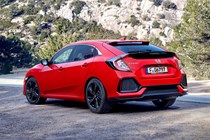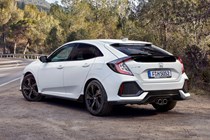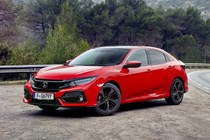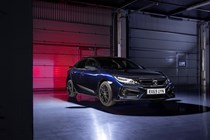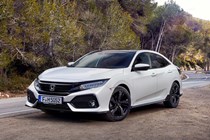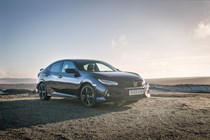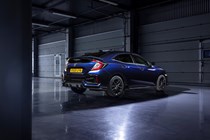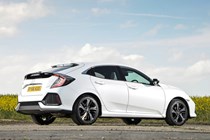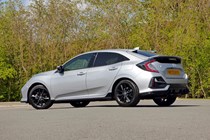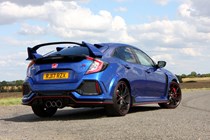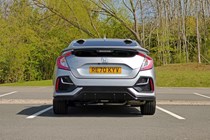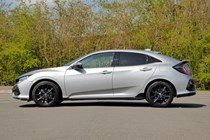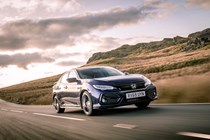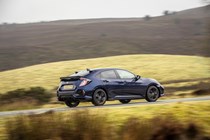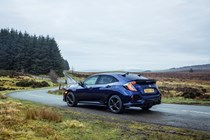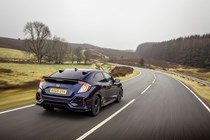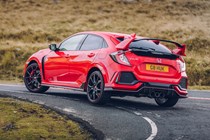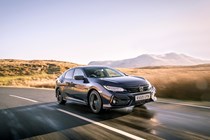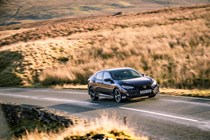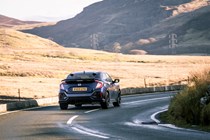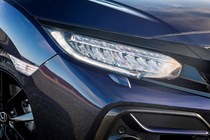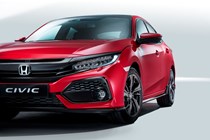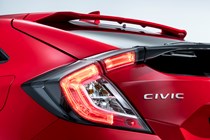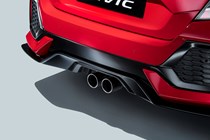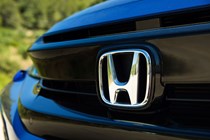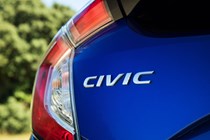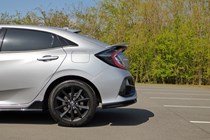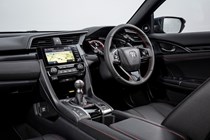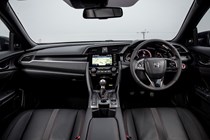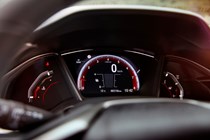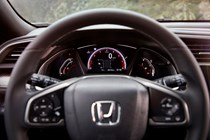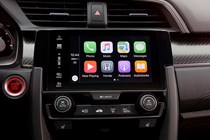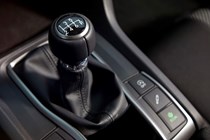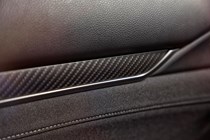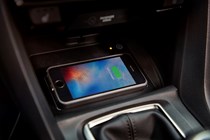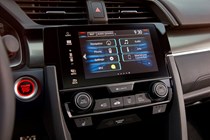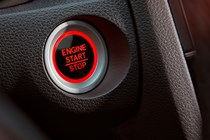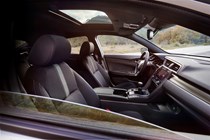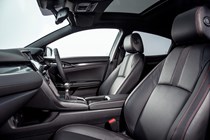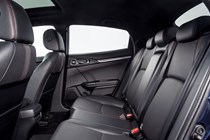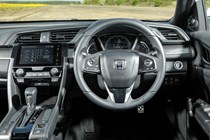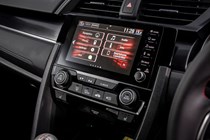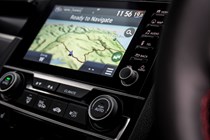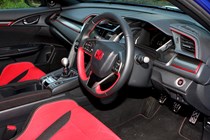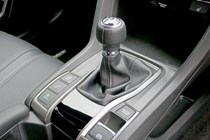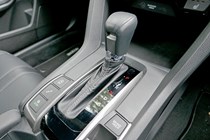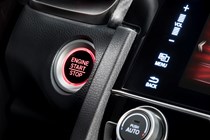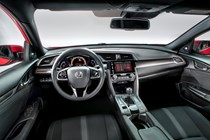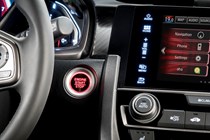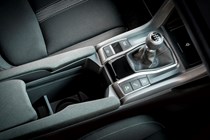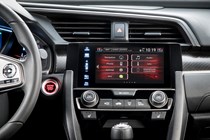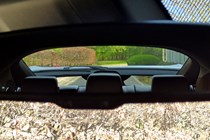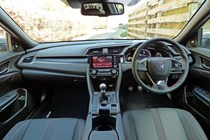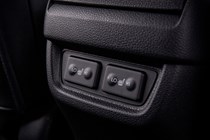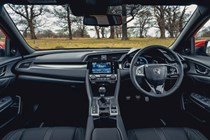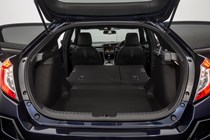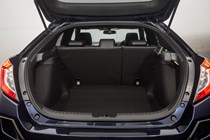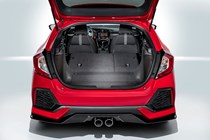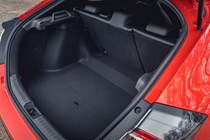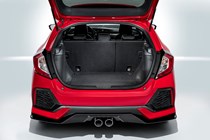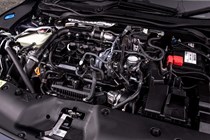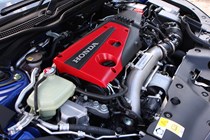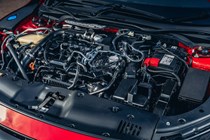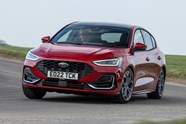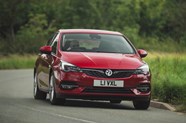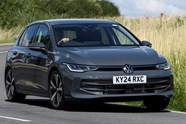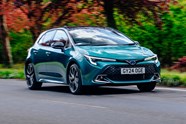
Honda Civic Hatchback (2017-2022) review
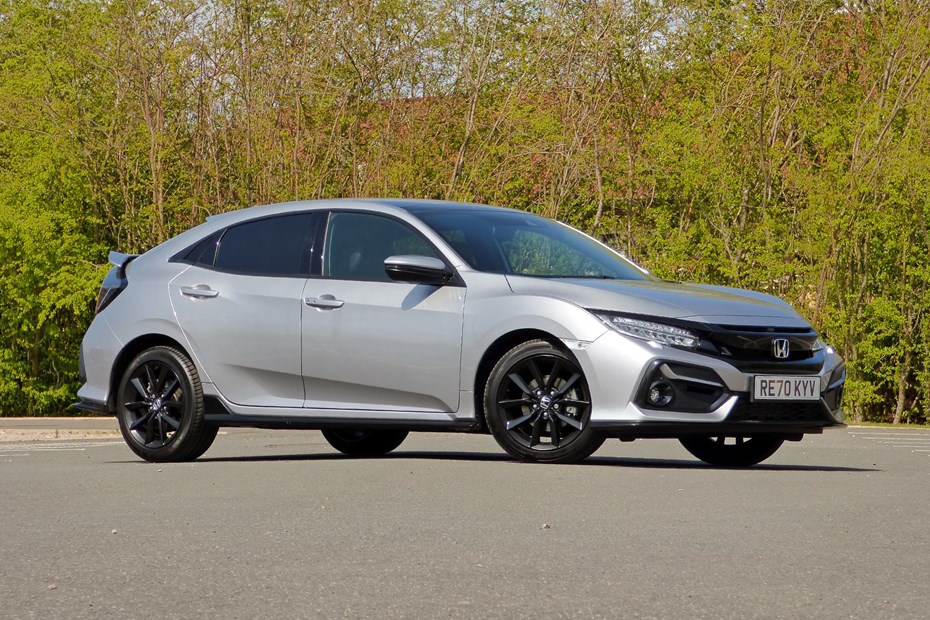
At a glance
| Price new | £18,650 - £28,965 |
|---|---|
| Used prices | £4,909 - £18,010 |
| Road tax cost | £20 - £195 |
| Insurance group | 15 - 22 |
Get an insurance quote with

|
|
| Fuel economy | 42.2 - 62.8 mpg |
| Range | 445 - 840 miles |
| Miles per pound | 6.2 - 8.0 |
| Number of doors | 5 |
| View full specs for a specific version | |
Available fuel types
Petrol
Diesel
Pros & cons
- Good to drive
- Spacious interior
- Eye-catching appearance
- Lower and harder to get into than some rivals
- Refinement could be better
- Some serious reliability concerns
Honda Civic Hatchback (17-22) rivals
Overview
The Honda Civic has a long history. The nameplate dates back to 1972 and over that time it has built a reputation for strong reliability. Here, however, we’re dealing with the 10th-generation hatchback model, known by the internal code name Honda Civic FK, and if you’re considering one as a used car you need to know this is an unusual example of Honda slightly blotting its copy book. Introduced in 2017 and replaced in 2022, it’s powered by a range of turbocharged petrol and diesel engines, and none of them are entirely faultless.
Honda Civic Mk10 known faults and common problems
With its slightly controversial (read: ugly) looks, the Mk10 Civic never sold as well as its best hatchback rivals, the Volkswagen Golf and Ford Focus. But you should still find a reasonable supply on second-hand Honda Civics market.
Honda Civic used prices range from just under £10,000 for a high-mileage i-DTEC diesel to over £25,000 for a late-model 1.5-litre VTEC petrol – though it’ll need to be immaculate to command that.
Watch out for low mileage cars that have mostly done short journeys, as this can cause some reliability issues later on; ideally you want reasonable miles for the year and an extensive service history.
Buying guide
Common issues, and what to look for if you’re looking at getting one.
1. Brakes
Reports of squeaking, squealing noisy brakes were common when these cars were new and nearly new, so this is definitely something to listen out for when taking a test drive. Could be the brake pads, could be dust shields, could be a trapped stone – or even just a lack of copper grease. But whatever it is, Civics appear to be particularly prone to it.
2. Air-conditioning
Make sure the air-con blows cold before you buy and don’t accept any excuse about it ‘just needing a re-gas’. Figuring out why the air-conditioning isn’t working on one of these isn’t always easy – which another way of saying it can be expensive to fix.
3. Thin paint
We’ve seen lots of complaints about thin or poor quality paint when these cars were new, so this is definitely something to look out for when buying used and may make spotting accident repairs more difficult as the paint was patchy to start with. Thin paint typically stonechips more easily and may result in earlier corrosion (rust).
4. Turbo failures
All of the FK Civic’s engines are turbocharged, and turbo failures aren’t unheard of. The 1.0-litre petrol is the most prone to this, seemingly due to its ‘wet belt’ design that sees the drive belt pass through the engine oil. This causes the belt to gradually disintegrate and the resulting swarf clogs the turbo, eventually resulting in failure.
Honda has paid for some repairs, seemingly ignored others. The best protection is excellent service history and shorter service intervals for the belt itself.
5. Oil dilution
The 1.5-litre turbo petrol has its own problems, and chief among them is an oil dilution issue. This refers to the oil being contaminated by petrol, reducing its effectiveness as a lubricant and even resulting in over-filling issues.
The root cause is the lengthy warm-up time of the turbocharged engine, and it therefore particularly effects cars that mostly do short journeys. Hence low mileage cars may suffer of have suffered with this issue more than others, and since it too can lead to turbo failure it’s another reason to be wary of below average miles. Honda deployed a software update in an effort to resolve the issue longer-term.
6. Diesel particulate filter (DPF)
Although Honda is most famous for its VTEC petrol engines it also builds a decent diesel engine – badged i-DTEC. The 1.6-litre version fitted in the Mk10 Civic is still a great choice for long-distance drivers as in they’re capable of 60mpg or more.
Not much seems to go wrong with these, but again be careful of low mileage cars. If they’ve mostly done short journeys the DPF may be clogged and on its way out.
7. Direct injection issues
Conversely, high-mileage turbo petrol Civics can suffer with issues related to direct injection engines. Honda is far from alone in having such problems – it’s in the nature of direct injection, unfortunately, which is prone to causing carbon build-up inside the engine that eventually degrades performance.
Using high quality fuel and even carbon-reducing additives may help, but they won’t cure the issue. Signs that its becoming a problem include more frequent spark plug replacement, so look for invoices relating to this in the paperwork before you buy.
8. Electrical gremlins
We could probably say this about any modern car, but electric gremlins can be a problem for the Civic Mk10. Alarm systems that won’t shut-up, defective active driver aids, even automatic wipers that go crazy – all of these are potential concerns that you should try to watch out for on the test drive.
9. Rattles
As the paint issues above also suggest, build quality could occasionally be patchy – often manifesting itself in the form of rattling trim. Sunroofs are worth a particularly close listen, as the problem can be tricky to solve.
10. General condition
Standard used car stuff, mildly exacerbated by the Civic’s typically older first buyer profile (a cliché for a reason), means you should look out for kerbed alloy wheels, dented and scraped bodywork and cars that have spent their lives doing short urban journeys and nothing more.
Mis-matched tyres are a sign of an uncaring owner, while uneven tyre wear speaks of bumped suspension and other issues that may prove irritatingly expensive to fix.
What models and trims can you buy?
The Mk10 Honda Civic came in a variety of trim levels over its lifetime, including the S, SE, SR, EX, EX Sport Line and Prestige. All come with a decent shot of standard equipment, with the arguable exception of the entry-level S, which didn’t sell in big numbers anyway.
Engines we’ve covered already, but in addition to the regular models there was also a Type R hot hatch. This we deal with in our separate Mk10 Honda Civic Type R review. There was a facelift in 2019, but this didn’t bring in major changes.
Over the next few pages, we’ll review each aspect of the Honda Civic Mk10, taking into account its practicality, comfort, fuel economy and performance. If you’re short on time, you can also skip to our verdict page to see if we recommend the 10th-generation Civic as a good used car.



